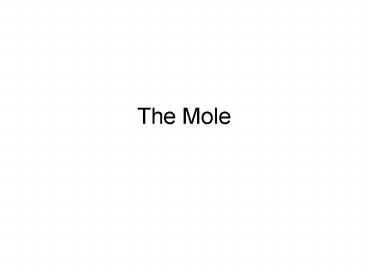The Mole - PowerPoint PPT Presentation
1 / 18
Title:
The Mole
Description:
The Mole. The Mole (Mol) Is a Number. Represents an amount of ... Units can be particles, atoms, molecules or formula units. You can have a ... peroxide: ... – PowerPoint PPT presentation
Number of Views:165
Avg rating:3.0/5.0
Title: The Mole
1
The Mole
2
The Mole (Mol)
- Is a Number
- Represents an amount of particles of a compound
- 6.022 x 1023
- Called Avogadros Number
- Units can be particles, atoms, molecules or
formula units - You can have a mole of anything
3
Converting between moles and particles
- 1 mole 6.022 x 1023 particles
- 1 mole
- 6.022 x 1023particles is a conversion factor
- How many moles are in 4.5 x 1030 atoms of Fe?
- 4.5 x 1030 atoms Fe x 1 mole
- 6.022 x 1023 atoms
4
Converting between moles and particles
- How many atoms of Na are there in 1.34 moles of
Na? - 1.34 moles x 6.022 x 1023 particles
- 1 mole
5
Practice
- Determine the number of Zn atoms in 2.50 moles of
Zn. - Calculate the number of molecules in 11.5 moles
of water. - How many moles make up 5.75 x 1024 atoms of Al?
- How many moles of CO2 are in 3.75 x 1024
molecules of CO2?
6
The Mole and Mass
- The mole represents 6.022 x 1023 particles of
anything - Those particles have masses
- Therefore the Mole can be related to a mass of
6.022 x 1023 particles. - This is called the molar mass (the mass of 1 mole
of a substance) - Molar mass vary with each substance
7
Molar Masses for elements
- The molar mass of an element is the atomic mass
on the periodic table followed by grams - Carbons atomic mass is 12.011
- The mass of 6.022 x 1023 atoms of carbon (1 mole)
12.011 grams
8
Molar Mass of Compounds
- The molar mass of a compound is the sum of all
the atoms masses that make up the compound - NaCl Na (23 grams) Cl (35 grams)
58 grams
9
Converting Using Molar Mass
- 1 mole
- Molar mass
- Determine the mass of 3.57 moles of Al
- 3.57 moles Al x 27 g Al
- 1 mole Al
10
Converting Using Molar Mass
- Determine the number of moles found in 25.5 g of
Ag. - 25.5 g Ag x 1 mole Ag
- 108 g Ag
11
Practice
- Determine the mass of 42.6 mol of Si
- Determine the mass of 3.45 x 102 mol Co
- Determine the mass of 2.45 x 10-2 mol Zn
- Determine the number of moles in 300.0 g S
- Determine the number of moles in
- 1.25 x 103 g Zn
- Determine the number of moles in 1.00 kg Fe
12
Empirical Formulas
- The simplest ratio of atoms found in a compound
is called the empirical formula. - Can be calculated by knowing a compounds percent
composition.
13
Percent Composition
- Percent by mass () Molar mass of element x 100
- Molar mass of the compound
14
Calculating Composition
- Compound is peroxide H2O2
- Find the mass of each element (if there is more
than one atom of an element, the mass must be
multiplied by the subscript) - 2 x H 2 x 1.0 g ? 2 g
- 2 x O 2 x 16.0 g ? 32g
- Find the Total Mass 34 g
- H 2 g x 100 5.9 H
- 34g
- O 32 g x 100 94.1 O
- 34 g
- To check your answer make sure the add up to
100
15
Practice
- Calculate the percent composition of each element
in the compound Calcium sulfate. - Calculate the percent of potassium in KCl
- Calculate the percent composition of the compound
diphosphorus pentoxide. - Calculate the percent composition of carbon
dioxide
16
Determining Empirical Formulas
- Drop all signs and add (g) unit
- Convert all grams to moles using the elements
molar mass. - Divide all mole amounts by the smallest mole
- As long as the number is a whole number it now
becomes that elements subscript - Special rounding is sometimes necessary
- If the decimal is .25 multiply by 4
- If the decimal is .33 multiply by 3
- If the decimal is .5 multiply by 2
- This creates a whole number
17
Practice
- Methyl Acetate is a solvent commonly used in some
paints, inks, and adhesives. Determine the
empirical formula for methyl acetate, which has
the following chemical analysis 48.64 C 8.16
H and - 43.20 O.
18
Practice
- Determine the empirical formula for a compound
that contains 35.98 Aluminum and 64.02 sulfur.































